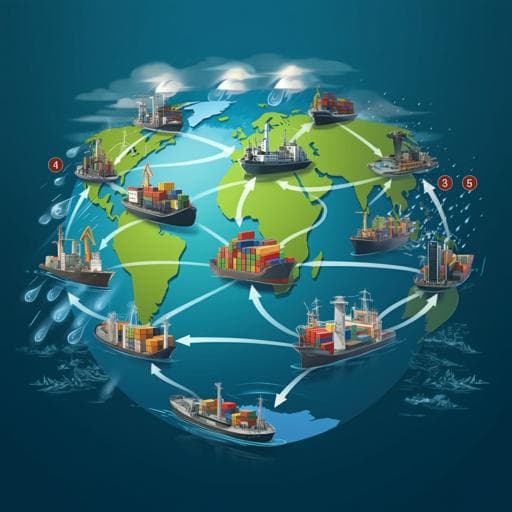
Transportation
Multi-hazard risk to global port infrastructure and resulting trade and logistics losses
J. Verschuur, E. E. Koks, et al.
Discover the alarming reality of global port infrastructure risks, as this study uncovers $7.5 billion in port-specific damages and a staggering $63.1 billion in at-risk trade flows annually. Conducted by Jasper Verschuur, Elco E. Koks, Sihan Li, and Jim W. Hall, this research highlights the urgent need for tailored solutions to enhance port resilience against multiple hazards.
~3 min • Beginner • English
Introduction
Ports are critical nodes in global supply chains but are exposed to climate extremes and natural hazards due to their coastal and riverside locations. Disruptions at ports can propagate through maritime transport and global supply chains, causing significant economic losses beyond port boundaries. Existing large-scale studies often assess hazard exposure at single points without asset-level detail or fail to capture disruption pathways and associated economic losses, while detailed asset-level analyses are limited to a small number of ports. Key gaps include the lack of a global port asset database, limited consideration of interdependent critical infrastructure (road, rail, electricity), and coarse hazard data resolution. Additionally, logistics losses from trade delays are under-quantified globally due to limited port-level trade flow data. This study aims to bridge these gaps by conducting the first global, asset-level, multi-hazard risk analysis for 1,340 ports, quantifying both damages and downtime-driven logistics and trade risks, and investigating the role of port resilience (engineering standards, operational thresholds, and recovery duration) through sensitivity analysis.
Literature Review
Prior large-scale analyses focused mainly on exposure to coastal flooding or operational thresholds, typically representing ports as points and lacking asset-level damage and downtime quantification. Detailed asset-level studies exist but cover few ports and often omit interdependencies with land-side infrastructure. Literature indicates critical land-side infrastructure failures can halt port operations, highlighting the need to include these dependencies. Studies document significant logistics losses from port disruptions (e.g., Suez Canal blockage) and frequent cyclone-related downtimes, but global quantification of logistics losses is scarce due to data limitations. Previous work has identified regions with high multi-hazard exposure (e.g., Japan, SE Asia, Caribbean), but adding fluvial, pluvial, and earthquake hazards provides a more nuanced global exposure picture. The importance of engineering standards and uncertainties in depth-damage functions have been highlighted in broader infrastructure risk studies.
Methodology
The study develops a comprehensive multi-hazard, asset-level risk framework covering 1,340 ports worldwide. Key components: (1) Port and critical infrastructure database: Manually mapped >13,000 port land-use polygons in QGIS (Google Satellite), categorized into seven main types (Container, Dry Bulk, General Cargo, Liquid, RoRo, Storage, Other). Industrial facilities near ports were extracted from OpenStreetMap and supplemented by manual mapping (>2,000 facilities). Critical infrastructure within a 1-km buffer around port/industry areas includes roads (GRIP), rails (OSM), electricity transmission (Gridfinder), and power plants (WRI and coal plant databases). Ship-to-shore crane counts were estimated from maximum daily container vessel calls and average cranes per vessel. (2) Operational (maritime extremes) downtime: Four operational thresholds considered—wind (17 m/s; crane serviceability), temperature (35°C globally; 45°C in Middle East; assumed 3 h/day productivity loss when exceeded), significant wave height (5 m for normally exposed ports; 4 m for highly exposed open roadsteads), and wave overtopping (tolerable rates: 0.4 l/s/m for seawalls, 1 l/s/m for breakwaters). Exposure to waves/overtopping determined using manually mapped breakwaters and World Port Index shelter types. ERA5 (1979–2018) provided wind, temperature, and wave parameters; waves were propagated to port entrances; overtopping estimated using synthetic breakwater designs. (3) Physical asset damages and recovery: Five hazards—tropical cyclone (TC) wind, earthquakes, fluvial (river) flooding, pluvial flooding, and coastal flooding. Standard risk approach overlays hazard intensities with asset locations using hazard- and asset-specific fragility curves and reconstruction costs; area/length-weighted aggregation yields port-wide damage fractions. Recovery times estimated via recovery curves (and event-based TC downtime model) to determine downtime for essential components. Earthquakes: UNISDR GAR2015 PGA maps (multiple return periods), fragility curves by land-use type and critical infrastructure; recovery based on FEMA HAZUS Earthquake Manual; maximum port recovery comparable to Kobe (≈2 years). TC wind: 10,000 years of synthetic tracks; Holland wind profile with Lin & Chavas parameterization; assets affected include industrial facilities, liquid/bulk terminals, warehouses, cranes; roads/rails assumed unaffected; downtime via regression on 107 observed TC-induced port shutdowns including maximum wind, duration above 15/35 m/s, closest approach, shelter, port size, pilot assistance (R2=0.75). Fluvial/pluvial flooding: JBA global inundation maps (20–1500-year return periods, ~30 m). Fluvial protection standards from FLOPROS; pluvial protection not applied due to data gaps. Fragility/recovery as per flood literature; max port recovery ≈120 days; critical infra recovery guided by observed cases. Coastal flooding: Constructed port-specific extreme water level (EWL) time series from Tide + Surge (GTSR) + Sea level anomaly (satellite altimetry) + Wave setup (if exposed; fraction of Hs or transmitted wave behind breakwaters via Goda-type transmission). Return periods via GEV methods; flooding extents with JAXA AW3D30 DEM (30 m). Same fragility/recovery as fluvial/pluvial; coastal flood protection standards from literature applied. (4) Port downtime via fault tree analysis (FTA): Nodes include terminals, cranes, road, rail, and electricity; OR-gate logic; port downtime equals the longest recovery among failed essential components for a hazard event/severity. (5) Logistics losses: Sum of three components due to downtime ΔT and daily flow f (tonnes): port operator revenue loss (loading/unloading fee), shipper loss (inventory cost + value of time), and carrier loss (late delivery proxy via freight rate). Parameter values from prior studies; value of time and daily freight flows from AIS-derived port trade data. (6) Risk metrics: Port-specific risk equals annual expected damages (AEL) to port and critical infrastructure plus logistics losses due to downtime from both operational exceedance and reconstruction. Trade risk equals annual expected downtime times average daily trade value per port; expressed in USD and as a fraction of total trade. Trapezoidal integration over return periods used; hazards treated as independent. (7) Sensitivity analysis: Variance-based Sobol analysis (SALib) with 10,000 samples; uniform distributions for most parameters (normal for TC regression uncertainty). Conducted globally and per port. Aggregated sensitivity contributions into three resilience indicators—Operational (operability thresholds and breakwater parameters), Engineering standards (depth-damage curves), and Recovery (recovery curves and max durations).
Key Findings
- Multi-hazard exposure: 94.8% of ports are exposed to more than one natural hazard; 86.2% to more than three hazards. Fluvial flooding exposure at 80.4% (70.9–81.4%) and pluvial flooding at 84.3% (57.8–88.2%) of ports. About 40.1% (22.1–63.1%) encounter maritime extremes exceeding operational thresholds. Hotspots include Japan, U.S. West Coast and Middle America, New Zealand, Taiwan, and parts of China; lower exposure in parts of South America, Africa, and Northern/Eastern Europe.
- Global port-specific risk: Median 7.6 (5–95% CI: 4.0–17.4) USD bn/year. Hazard contributions (median): tropical cyclones 2.4 (0.7–12.2) bn; fluvial flooding 1.9 (0.7–12.2) bn; coastal flooding 0.8 (0.5–1.23) bn; pluvial flooding 0.7 (0.2–1.6) bn; operational exceedances 0.5 (0.06–2.4) bn; earthquakes 0.2 (0.1–1.3) bn. Dominant hazards vary regionally: TC leads for 25.2% of ports (Caribbean, East Asia, N. Australia); fluvial (22.6%) and coastal (23.7%) dominate in parts of Western/Northern Europe; earthquakes lead for 10.8% of ports (Chile, Mediterranean, N. Japan).
- Top at-risk ports (port-specific risk, median USD m/year): Houston 169.0; Shanghai 133.2; Port Elizabeth 123.4; Lázaro Cárdenas 110.9; Rouen 98.7. Dominant hazards: Houston (TC wind, pluvial, fluvial), Shanghai (TC wind), Rouen and Lázaro Cárdenas (fluvial), Port Elizabeth (operational exceedances; extreme waves). About half of ports face >1 m/year risk; 160 ports >10 m/year; 21 ports >50 m/year.
- Relative risk by income/size: Relative risk (USD/year/m2) is 123.4 (55.7–379.5) in high-income, 117.7 (45.7–312.1) in low-income, 118.4 (53.3–404.7) in upper-middle, and 155.5 (87.4–377.6) in lower-middle income countries. Small ports in low-income and upper-middle-income countries often face higher relative risks, especially for critical infrastructure dependencies. Larger ports have higher absolute risks but generally lower relative risks.
- Risk factor contributions to port-specific risk: Port infrastructure damages account for 58.6% globally; logistics losses 22.2%; critical infrastructure damages 19.2%. For TC-induced risk, logistics losses are ~30%, reflecting frequent downtime; for earthquakes/logistical floods, logistics shares are smaller (1.2%–8%). Critical infrastructure damages contribute notably to coastal (28.2%), pluvial (24.5%), and fluvial (22.8%) flood risks.
- Trade risk: Median 66.9 (47.1–109.7) USD bn/year, equivalent to 0.80% (0.53–1.76%) of total maritime trade value at risk annually. High trade risk clusters in cyclone-prone East Asia. 27 ports each exceed 0.5 bn/year trade risk; highest at Shanghai, Ningbo, Kaohsiung, Xiamen, Busan. Small Island Developing States (SIDS) experience trade risk 3.7 times higher on average than non-SIDS. Highest trade bottleneck risks (% of annual maritime trade value): Northern Mariana Islands 1.8% (1.1–4.0%), Guinea-Bissau 1.7% (0.1–6.9%), Guam 1.5% (0.9–3.5%), Philippines 1.3% (0.9–2.9%), Saint Vincent and the Grenadines 1.2% (0.8–2.0%), Dominica 1.2% (0.9–2.2%).
- Uncertainty and resilience sensitivities: Relative uncertainties in port-specific risk are larger in Africa, the Middle East, and East Asia; for trade risk, uncertainties are larger in Northern Europe, Africa, South America, and the Mediterranean. Port-specific risk variance is mainly driven by engineering standards (depth-damage curves). Operational resilience is critical for some ports highly exposed to maritime extremes (e.g., Port Elizabeth). Trade risk variance is driven by a combination of engineering, recovery ability, and operational resilience; reducing recovery duration and improving operability have strong effects on trade risk by reducing downtime.
Discussion
The study addresses the lack of global, asset-level, multi-hazard risk quantification for ports by integrating detailed infrastructure mapping, multiple hazard processes, operational thresholds, and interdependencies with critical land-side infrastructure. Findings confirm that most ports face multiple hazards, with TC winds and various types of flooding being primary drivers of risk. The results demonstrate the spatial heterogeneity of dominant hazards and risk magnitudes, showing that resilience factors—engineering design standards, operability thresholds, and recovery capacity—strongly modulate risk at individual ports. The analysis reveals that damages to port assets dominate port-specific risk, but the roles of critical infrastructure failures and logistics losses are non-negligible and can be dominant for subsets of ports. Trade risk findings underscore systemic vulnerability, particularly in cyclone-prone regions and SIDS, where even moderate downtimes translate into disproportionately high shares of national trade at risk. By quantifying both direct asset losses and downtime-driven logistics and trade risks, the study provides a framework that directly informs adaptation priorities: enhancing engineering standards (e.g., flood protection, elevation, seismic design), strengthening interdependent infrastructure resilience near ports, and improving operational thresholds and recovery planning to mitigate frequent downtime. The sensitivity results indicate where targeted improvements in resilience could most effectively reduce uncertainties and risks, thereby guiding tailored, port-specific risk management strategies.
Conclusion
This work delivers the first global, asset-level, multi-hazard risk assessment for ports, quantifying annual expected port-specific losses (damages to port and critical infrastructure plus logistics losses) and trade at risk from downtime. It shows that the vast majority of ports are exposed to several hazards, with tropical cyclones and flooding dominating global risk, and that trade disruptions can be substantial, especially for SIDS. The framework highlights the importance of local resilience factors—engineering standards, operability, and recovery ability—in shaping risk outcomes and uncertainties. The new port asset and hazard-downtime databases, together with the integrated fault-tree and logistics loss modelling, offer actionable insights for policymakers, investors, insurers, and port operators to prioritize adaptation investments and operational improvements. Future research should incorporate compound and consecutive hazards, expand to include tsunami risk, refine local protection standards and operational thresholds, and evaluate climate change impacts on hazard intensities and sea levels. This will enable comprehensive adaptation planning, including elevating terminals, improving flood defences, retrofitting infrastructure, and enhancing business continuity to secure global supply chains.
Limitations
- Hazard independence: The analysis treats hazards as independent, ignoring compound and consecutive events and multi-port simultaneous disruptions, potentially underestimating joint risks.
- Tsunami hazard omission: Tsunami risk is not included due to limited global modelling maturity, though low-probability events can cause severe port impacts.
- Data and resolution constraints: Global hazard datasets and DEMs may not capture fine-scale port elevations and features; synthetic breakwater designs approximate unknown local designs; coastal EWL components and wave transmission are simplified.
- Protection standards: Fluvial/coastal protection standards are included from global databases, but pluvial drainage standards are not applied due to data gaps, potentially overestimating or underestimating pluvial risks locally.
- Operational threshold generalization: Wind, temperature, wave, and overtopping thresholds are generalized; actual thresholds vary widely between ports, affecting downtime estimates.
- Recovery modelling simplifications: Recovery durations use generalized curves or an empirical regression (for TC downtime); local recovery capacity, supply chain logistics, and resource constraints may alter real-world downtime.
- Logistics cost parameters: Port charges, inventory costs, value of time, and freight rates are taken from literature averages; local variability is not fully captured.
Related Publications
Explore these studies to deepen your understanding of the subject.







